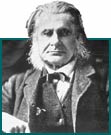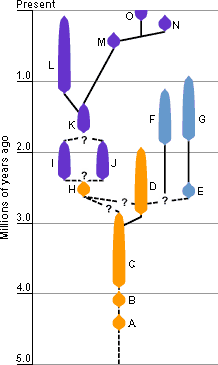When Charles Darwin wrote the Origin of Species, he had to wonder about how humans came to be. Humans had hereditary variation in every generation, and some individuals had more children than others — the key ingredients for natural selection. But he chose not to write about humans in his first book about evolution, in large part out of strategy. In 1857, two years before Darwin published the Origin of Species, Wallace asked him in a letter if he would discuss the origin of mankind in the book. Darwin replied, “I think I shall avoid the whole subject, as so surrounded with prejudices, though I fully admit that it is the highest and most interesting problem for the naturalist.”
But Darwin also knew that he had no fossil record to use to develop a hypothesis about human evolution. Over the years, naturalists had uncovered a few stone tools lying alongside the fossils of extinct mammals. But even in the 1800s, these relics were considered to be only a few thousand years old, and to have been made by lost tribes of savages.
First human fossils discovered
 Even when the first part of a fossil human came to light in 1857, naturalists had a hard time recognizing it for what it truly was. German miners working at the Feldhofer Grotto in the Neander valley dug up a skullcap. It looked somewhat human, but it was remarkably thick and sported a massive brow ridge. Did it belong to an ancient individual from a human-like species now extinct? Or was Neanderthal man just an extreme member of Homo sapiens? One of the German naturalists who described the skull for the first time, Herman Schaaffhausen, was convinced of the latter. He ignored evidence that the skull had been found alongside extinct cave bears and mammoths, and claimed that it was some recent barbarian, perhaps a member of one of the wild tribes mentioned by Roman historians.
Even when the first part of a fossil human came to light in 1857, naturalists had a hard time recognizing it for what it truly was. German miners working at the Feldhofer Grotto in the Neander valley dug up a skullcap. It looked somewhat human, but it was remarkably thick and sported a massive brow ridge. Did it belong to an ancient individual from a human-like species now extinct? Or was Neanderthal man just an extreme member of Homo sapiens? One of the German naturalists who described the skull for the first time, Herman Schaaffhausen, was convinced of the latter. He ignored evidence that the skull had been found alongside extinct cave bears and mammoths, and claimed that it was some recent barbarian, perhaps a member of one of the wild tribes mentioned by Roman historians.
 Shortly after Darwin published the Origin of Species, his great champion Thomas Huxley (right) considered the skull from the Neander valley. Huxley shared some of the Euro-centric notions of his time. Based on their skulls, it was thought that Europeans had the best-developed brains, compared to the Australian aborigines with skulls having relatively low profiles and thicker brows. This view led Huxley to consider Neanderthals as occupying a slightly lower position within Homo sapiens.
Shortly after Darwin published the Origin of Species, his great champion Thomas Huxley (right) considered the skull from the Neander valley. Huxley shared some of the Euro-centric notions of his time. Based on their skulls, it was thought that Europeans had the best-developed brains, compared to the Australian aborigines with skulls having relatively low profiles and thicker brows. This view led Huxley to consider Neanderthals as occupying a slightly lower position within Homo sapiens.
Darwin publishes on human origins
Amid these ambiguous developments, Darwin decided to say something about human origins. In 1871 he published The Descent of Man and Selection in Relation to Sex, in which he argued that all of the known evidence was consistent with humans having evolved from a common ancestor shared with apes. He speculated that Africa was their place of origin and that human ancestors had gradually taken on their current form since then. He suggested that natural selection was not the only evolutionary pressure at work. Women might have preferred different traits in men, what Darwin called sexual selection, and this might have given rise to differences between the races. Darwin’s ideas did not persuade his old correspondent, Alfred Russel Wallace. Wallace decided that our oversized brains were far more powerful than necessary — we could easily survive with minds slightly more advanced than an ape’s. The creation of humans must, he concluded, be the work of divine intervention.
More human fossils discovered

Fossils would be crucial to resolving this debate, but they were slow in coming. It was not until 1886 that Neanderthal fossils were discovered for a second time — and this time, they included the jaw and other parts of the skeleton. Found in Spy, Belgium, these clearly came from ancient rocks, demonstrating that Neanderthals were not some barbarian tribe that lived a few centuries ago. The next year, Eugene Dubois (left), a young anatomist from Holland traveled to Indonesia in the hopes of finding fossils of early man. Since orangutans lived there, and since Dubois managed to secure a job as a medical officer in the Royal Dutch East Indies Army, it seemed like a good place for him to go prospecting. After four years of struggles, he hit pay dirt when he dug a pit in the side of the Solo River in eastern Java. He found fossil remains of something not quite human, but not quite ape. It stood upright, but its brain was far too small to qualify as human. It became known as Pithecanthropus erectus, meaning “upright ape-man.”
Fossil evidence and the acceptance of human evolution

Dubois came back to Europe in 1895 to champion his discovery. He met with some stiff opposition from skeptics. Some wondered whether the ape-like skull and the human-like femur came from the same skeleton. Others thought the skull was similar to Neanderthals. Dubois became embittered by the debate over his bones and hid the fossils from other scientists. But in time, as more fossils were uncovered in Asia, scientists came to recognize that Dubois had indeed found the first representative of the ancient species, Homo erectus.
The twentieth century brought a great many more fossils of humans and hominids. Today twenty hominid species have been identified, the oldest of which date back six million years. They point to an African origin, as Darwin had proposed. Hominid evolution was sometimes pictured as a single line of descent and a steady progression from primitive forms to more advanced forms. The fossils suggested otherwise. Instead, hominid evolution produced a dense thicket of branches, with several species co-existing at any given time except for the last 30,000 years or so. Added to this wealth of data is the knowledge gathered from comparisons of DNA from humans, apes, and even Neanderthals. While many questions remain to be answered about human evolution, scientists have a growing treasury of evidence at their disposal.

A-Ardipithecus ramidus
B-Australopithecus anamensis
C-Australopithecus afarensis
D-Australopithecus africanus
E-Paranthropus aethiopicus
F-Paranthropus robustus
G-Paranthropus boisei
H-Australopithecus garhi
I-Homo rudolfensis
J-Homo habilus
K-Homo ergaster
L-Homo erectus
M-Homo heidelbergensis
N-Homo neanderthalensis
O-Homo sapiens

